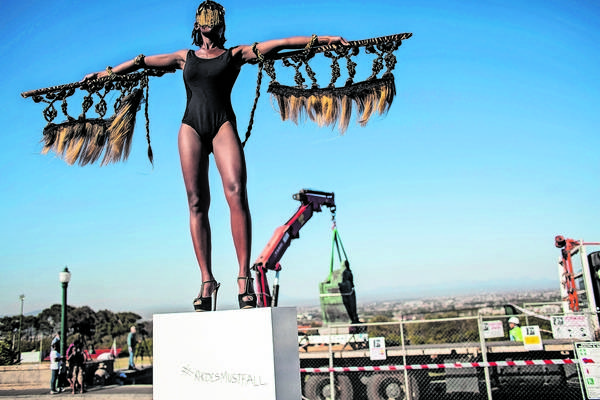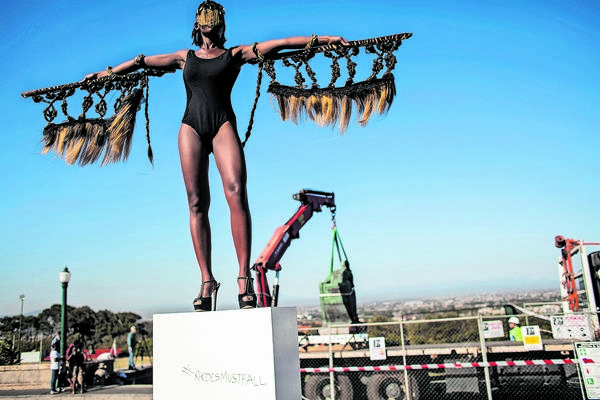

In 2003, Olive Schreiner (1855–1920), perhaps best known for her novel The Story of an African Farm (1883), was posthumously awarded South Africa’s Order of Ikhamanga in Gold.
The national award highlighted her “commitment to the struggle for human rights and democracy”. In 2020, reflecting on this commemorative recognition and the centenary of Schreiner’s death, Jade Munslow Ong evoked the idea of Schreiner as an early #RhodesMustFall proponent.
There is much to be said for exploring the resonances between Schreiner’s strident public censure from the late 1890s of Cecil John Rhodes’s capitalist imperial project and the #RhodesMustFall student movement in South Africa more than a century later. In fact, soon after the emergence of this decolonial movement scholar Lucy Graham compared it with Schreiner’s anti-Rhodes activism.
In March 2015, in a moment that catalysed the protests in Cape Town and internationally, University of Cape Town student Chumani Maxwele, the son of a miner and domestic worker, threw excrement at the statue of Rhodes on campus, calling out to the gathering crowd: “Where are our heroes and ancestors?” Weeks of campaigning followed to remove the statue. Its white-supremacist symbolism, protesters argued, was an “embodiment of black alienation and disempowerment” over the centuries into the present day.
An important expression of #RhodesMustFall’s activism was to use creative forms to deliver its messages as Schreiner had done more than a century before, Graham notes. In April 2015, to mark the statue’s removal, artist Sethembile Msezane choreographed a performance piece in which she depicted the legendary Zimbabwean Chapungu bird bearing witness to the symbolic fall of Rhodes. Highly conscious of Rhodes’s “wrongful appropriation” of this emblematic bird from Great Zimbabwe to represent his imperialist creation of Rhodesia, Msezane could not let this historic moment of figurative encounter and retributive justice pass.
Elevated on her own plinth as the Chapungu bird, she lifted the artificial wings strapped to her arms in a profound gesture of ascent as Rhodes’s statue was unceremoniously unseated. In claiming this public ceremonial space, Msezane reaffirmed the histories and lived realities of pre- and anti-colonial Zimbabwe and Africa more generally — not least of its women marginalised by the racial and gender hegemonies of colonialism. All too aware “that South Africa’s memorialised public spaces are barren of the black female body”, Msezane offered a highly attuned, historically significant response to #RhodesMustFall.
While #RhodesMustFall made searing socio-political and economic connections in the present and precipitated an era-defining movement, it did not at the time specifically link its 21st-century protest action to the vocal, multi-sited anti-Rhodes activism of the past, including that of Schreiner, as Heather Hughes observes. Counted among Rhodes’s detractors during his lifetime, for example, was John Langalibalele Dube, educationist, journalist and missionary, who in 1912 would assume presidency of the nascent African National Congress (loosely becoming part of Schreiner’s network).
When Dube was studying and travelling as a young man in the United States during the 1890s, he wrote in the Los Angeles Times about the deadly hand of Rhodes in the region, registering a sense of how it implicated black people across the region. He inscribed the collective “us” into his analysis and invoked the shared status of oppression owing to race: “Rhodes and the other officials of the South Africa Company, we have found by fearful experience, are trying to put all they can in their pockets by killing and plundering us.” Dube railed against the violent 1896-97 seizures by Rhodes and his British South Africa Company of Shona and Matabele land north of the Limpopo, with brutal crackdowns on resistance.
Indeed, representatives from across the black diasporic world, as well as those from all backgrounds in Britain and the Empire, levelled criticism against Rhodes just as others lauded him. At the turn of the new century, the inaugural 1900 Pan-African Conference in London petitioned Queen Victoria about the “degrading and illegal compound system of labour in vogue in Kimberley and Rhodesia” attributed to Rhodes’s racial capitalism. Prominent black intellectual WEB Du Bois, leader of the African American delegation to the 1900 Conference, was to have a direct influence on Schreiner with his exposition of the “colour line” becoming the overarching issue of the 20th century.
Schreiner, who keenly observed socio-political developments on her return to South Africa from Britain in 1889 and who interacted with several black leaders and thinkers over time, became one of most vociferous critics of Rhodes after her earlier, if short-lived, regard for the scope of his knowledge which she had experienced first-hand in Cape social circles.
However, Rhodes’s support for the “Strop Bill”, which sanctioned the flogging of black servants and workers under contract in the Cape, presented a stark turning point for her. As she wrote to her sister Ettie Stakesby-Lewis, she “accepted no invitation to his house or had anything to do with him” once his brutal human dealings, hard-line segregationist policies, and networks of influence and corruption became irrefutably clear. “The perception of what his character really was in its inmost depths was one of the most terrible revelations of my life,” she commented.
In addition to public speeches, many press pieces, and her pamphlet The Political Situation (1896), Schreiner took Rhodes on through her piercing book-length allegory, Trooper Peter Halket of Mashonaland (1897). It exposed his violent incursions to annex territory and resources at great human cost. “What an accursed spite it is that the two people of genius which South Africa has produced should be in opposite camps,” wrote WT Stead, editor of the prominent British periodical Review of Reviews, who despite his great regard for Schreiner touted Rhodes’s grand vision until he later reversed his position.

The first edition of Trooper Peter Halket, featuring the chilling photographic frontispiece of three executed black men hung as “rebels” from a tree, sent shockwaves across London, the British Empire and beyond. We know that Cape African newspaper editor John Tengo Jabavu visited Schreiner on his return from investigating the Rhodes-backed atrocities, corroborating accounts of the colonial violence north of the Limpopo.
Published at the same time that the British Parliamentary Sub-Committee was investigating Rhodes’s role in the scandalous 1895-96 Jameson Raid on the mineral-rich Transvaal Boer republic, an act that would contribute to the triggering of the South African War (1898-1902), Trooper Peter Halket injected further energy into the public debate around the mining magnate-cum-politician’s commercial exploits and complicities. Rhodes was not ultimately indicted for the bloody Mashonaland and Matabeleland invasions, but was forced to resign as Prime Minister of the Cape owing to his association with Jameson.
Schreiner’s horror over Rhodes’s actions was such that she wrote later of Trooper Peter Halket as being her most important, if not her best, book. She wrote that the allegorical exposé would offer her a measure of “comfort” on her deathbed. It came at a great cost, however. Rhodes’s backlash attempted to cripple her financially (“get his teeth fast into us”) through a lawsuit his associate took out against Schreiner’s husband Samuel “Cron” Cronwright. Rhodes’s vengeance took other forms too, including attacking Schreiner in the white press and orchestrating hate mail.
In her time, Schreiner’s denunciation of Rhodes was no less public condemnation and exhibition than #RhodesMustFall activism has been in the contemporary period. Furthermore, Schreiner’s emphasis more than a century ago on the extent to which Rhodes both enabled and emerged from a system has been strikingly prescient of #RhodesMustFall’s focus on the structural power of coloniality.
“If [Rhodes] passed away tomorrow,” Schreiner wrote in 1897, “there still remains the terrible fact that something in our society has formed the matrix which has fed, nourished and built up such a man!”
While Rhodes undoubtedly “shaped the world from beyond the grave”, to borrow Hedley Twidle’s words, he could not thwart his detractors then or now. Interrogations of Rhodes’s legacy, and the systemic nature of white privilege and “institutional colonialism”, show no signs of dissipating. The 21st-century #RhodesMustFall campaign has powerfully inspired other Fallist struggles, including #RMFOxford, while forging deep-seated solidarities with the #BlackLivesMatter social justice movement in the US and around the world.
In a sense, those today who take on entrenched exclusionary structures and their spectres join intellectual-activist ancestors including Schreiner in profoundly recasting visions of society to embody and empower all.
• Olive Schreiner: Writing Networks and Global Contexts is edited by Jade Munslow Ong and Andrew van der Vlies and published by Edinburgh University Press.
• Janet Remmington is a scholar, writer and publisher. She holds research associate positions at the University of the Witwatersrand and the University of York.
The post The long story of #RhodesMustFall appeared first on The Mail & Guardian.
This is an edited extract of Janet Remmington’s chapter titled ‘Olive Schreiner, Race and Black South Africa’, from Olive Schreiner: Writing Networks and Global Contexts
The post The long story of #RhodesMustFall appeared first on The Mail & Guardian.




